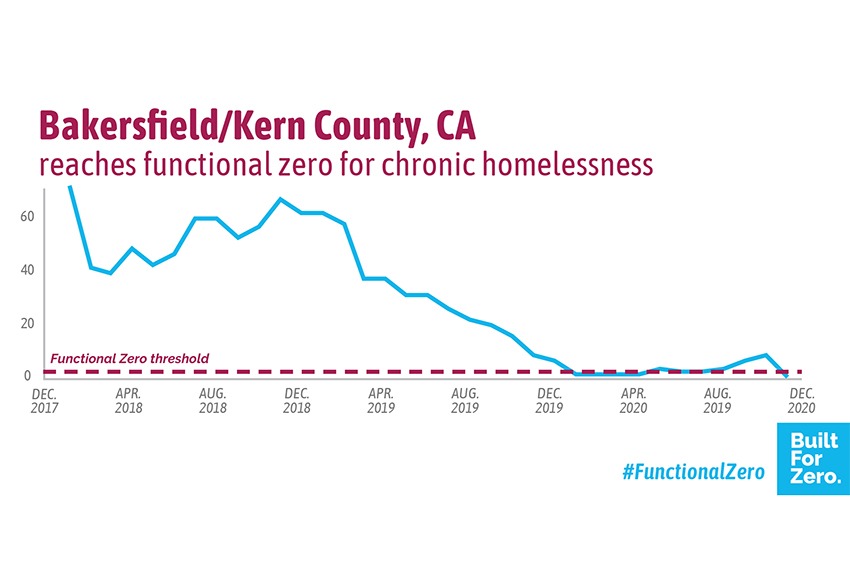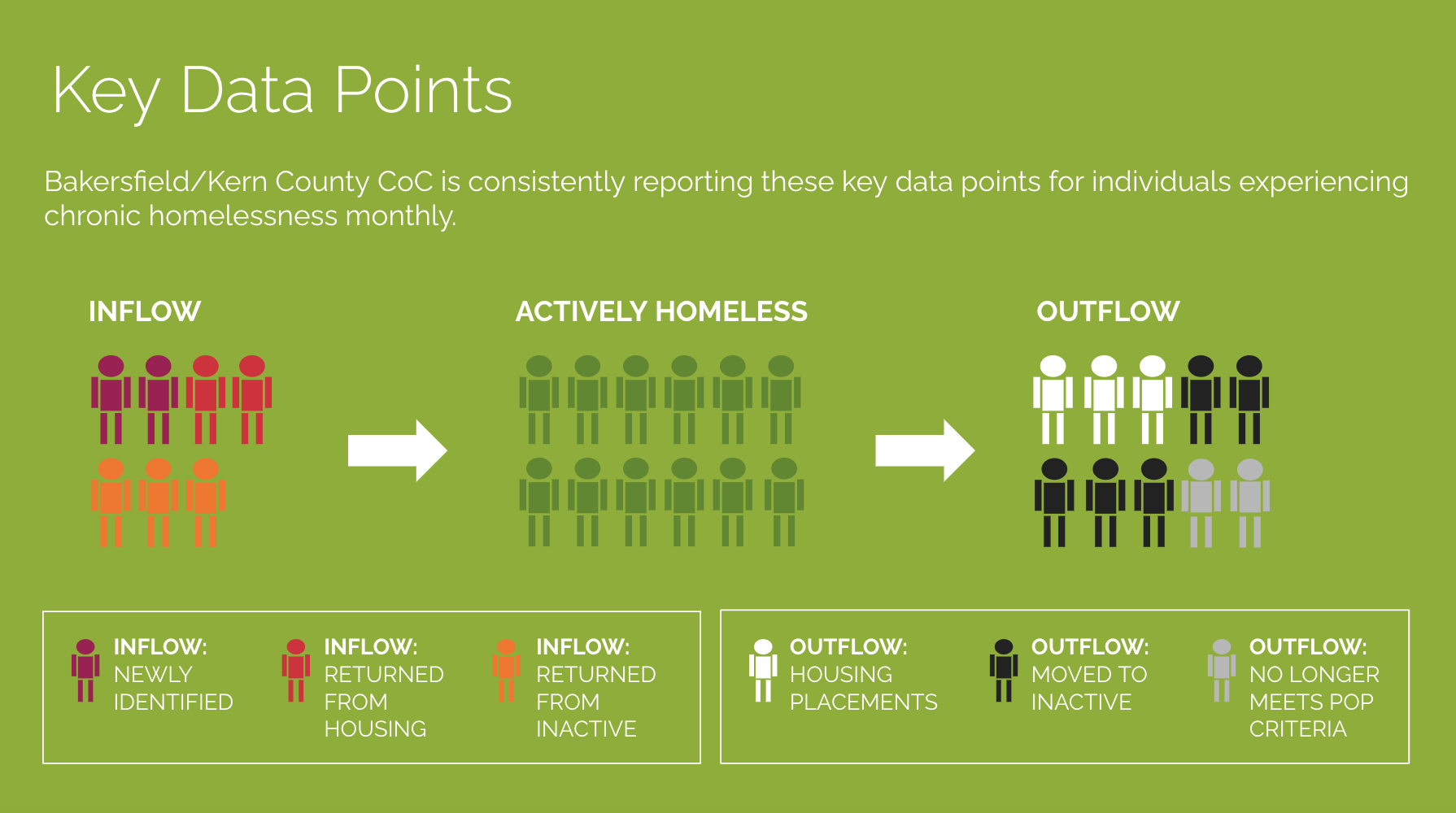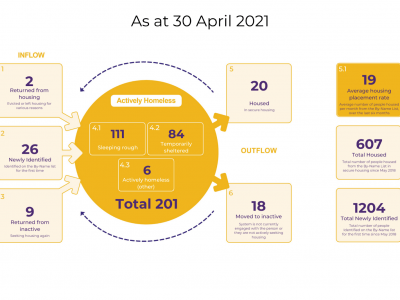COVERAGE AREA
Cities: 11
Counties: 1
Total Population: 900,202
The Achievement
FUNCTIONAL ZERO FOR CHRONIC HOMELESSNESS
- Milestones Reached: Chronic (2020)
- Next Population for Focus: Homelessness for all populations
In March of 2020, Bakersfield and Kern County joined an elite group of just five communities in the United States that have been certified for functional zero for chronic homelessness. The community is part of Built for Zero, a movement of more than more than 80 communities committed to measurably ending homelessness, one population at a time. The Continuum of Care for Bakersfield/Kern County joined Built for Zero in 2015.
Chronic homelessness describes people who have experienced homelessness for at least a year — or repeatedly — while struggling with a disabling condition such as a serious mental illness, substance use disorder, or physical disability.

A community has reached functional zero for chronic homelessness when three or fewer people are experiencing chronic homelessness (or 0.1% of the community’s most recent total homelessness individual point-in-time count, whichever is greater). This definition is shared between Built for Zero and the federal government.

By reaching functional zero, Bakersfield and Kern County have proven it’s possible to build a system of support that ensures their most vulnerable neighbors can leave homelessness behind. This does not mean that no one will ever experience homelessness again, but rather that the community has proven homelessness does not need to become inescapable or a way of life for a group of their most vulnerable neighbors. Bakersfield reached this milestone in January 2020, reducing the number of people experiencing chronic homelessness from 62 to two people in that month, and sustaining it through March 2020.
Even as numbers rose due to the COVID-19 pandemic, the community was able to drive the numbers back down, maintaining an average of four people experiencing chronic homelessness throughout the entire year of 2020.
Through a truly multi-faceted approach, the team learned to work differently and collaboratively to end chronic homelessness in their community. “I think it was the willingness and eagerness to implement something that they saw could help us move forward with this population,” said Heather Kimmel, Assistant Executive Director at the Housing Authority of the County of Kern and local improvement team leader. “It definitely would not have been seamless or easy without everybody just jumping on.”
Determined leadership of the Built for Zero team played a role in Bakersfield’s success. “Heather [Kimmel] drove it home,” said Deb Johnson of California Veterans Assistance Foundation. “Month after month just when we thought we were going to take a break… no, here comes another change idea. She really pushed us.”
Their work was and continues to be focused on not being afraid of “failing forward.” Kimmel explained they maintained this mindset: “‘If we succeed, great, if we fail, let’s do something a little different, and that’s a win as well.”
How did they do it?
As part of Built for Zero, Bakersfield changed how its homeless response system works by adopting the core elements of the Built for Zero methodology:
- Building a unified regional team, or a “command center,” around a shared aim of getting to functional zero
- Using real-time, person-specific data to know every person experiencing chronic homelessness by name and target efforts and resources accordingly
- Using data to redesign Bakersfield’s homeless response and strategically target resources
SHARED DEFINITIONS AND SHARED PURPOSE
The local Built for Zero team started by unifying the efforts of key agencies working locally to end homelessness. In many communities, local agencies or nonprofits focus on their piece of the solution, without an ability to see how all the pieces in their community fit together. Often, success is defined by each organization’s programmatic goals rather than whether the overall number of people experiencing homelessness is going down.
Bakersfield worked to reorganize their efforts around a shared goal of getting to zero on chronic homelessness. One of the key changes the team implemented was making sure everyone in each agency was using the same definition of “chronic homelessness.” The team realized there was no system-wide definition being used and discovered that working with a shared definition resulted in better housing outcomes for their clients.
As Deb Johnson, President of California Veterans Assistance Foundation explained, “When we all were on the same page and it made more sense, then it felt like we were on a significant roll at that point.” Operationalizing this newly shared definition was the next step in uniting the various agencies. “It was about just streamlining the processes to put people in the right vulnerability category so that the proper work and interventions could happen for them at the proper time,“ said Kimmel.
UNDERSTANDING THE PROBLEM THROUGH QUALITY REAL-TIME DATA

You cannot solve a problem that you don’t understand. In order to measurably end homelessness, communities need real-time, person-specific data. Traditionally, an understanding of the issue of homelessness in a community has been limited to an annual estimate of people experiencing homelessness, called the point-in-time count. This is an aggregate number that provides an estimate of people experiencing homelessness on a single night, but does not include the names or needs of the people who make up that number.
Communities in Built for Zero develop by-name lists, which provide real-time insights into everyone experiencing homelessness by name. This enables communities to triage that individual’s needs, understand if their investments and activities are driving homelessness down and test and innovate ideas that will move people out of homelessness faster.

By September 2017, the team had created a system that ensured quality data on every person experiencing chronic homelessness in their community. This data enabled them to understand who was moving out of homelessness, who was entering into it, and who was remaining on the list. Reaching this data reliability threshold signaled that data management practices were robust and efficient, and that data is being tracked in a consistent manner.
Once the team had reliable by-name, real-time data, they looked at how they could improve their homeless response system from a user-centered perspective. ”We were setting goals and understanding that the goal was a means to improve our system,” said Kimmel.
For example, their system had a bottleneck between the length of time a client was matched to a housing resource to the time they located a unit to move into. Once this was highlighted as a challenge to be addressed, the team submitted a proposal for an investment from Kaiser Permanente, a core partner of Built for Zero, to help fill a resource gap to help them on their journey to functional zero.
This proposal was granted in July 2019, allowing them to fund a new Housing Locator role to locate housing units and increase case manager capacity. This new employee utilized software called Padmission, which is a program like Zillow for rental units in a homelessness system, adding in notes about landlords that would work with chronic clients which case workers could reference when working with clients.
This support, along with valuable training from Kaiser Permanent, re-invigorated the community’s drive to reach functional zero for chronic homelessness. “It was a pipeline of units constantly coming in at real time,” said Kimmel.

USING DATA TO REDESIGN BAKERSFIELD’S HOMELESS RESPONSE AND TARGET RESOURCES
With a multi-agency command center team established and real-time, by-name data of all people experiencing chronic homelessness in hand, Bakersfield and Kern County set about testing change ideas in order to better target resources and continue improving their system.
Utilizing technology
As Bakersfield/Kern County improved their identification of people experiencing chronic homelessness, they also became more focused on engaging and housing the people on their by-name list. One improvement was fully utilizing available technology to further break down barriers, through the creation of an alert system in their Homeless Management Information System, or HMIS. The HMIS administrator would generate a daily report that outreach workers could take with them each morning to be on the lookout for those particular clients to keep them off of the “inactive” list. “So if we had somebody who we haven’t had contact with in 60 days, we would set an alert in HMIS,” said Kimmel.
Engaging Landlords
These improvement projects included holding a landlord summit in July 2018 in order to secure more housing units, along with investing in recruiting more landlords through webinars, mailing, and other conferences. While the response was not exactly as expected, the community learned that was not actually the biggest hurdle to overcome.
Case Conferencing
Improvement in the team’s case conferencing practice began in spring 2019, laying better groundwork for systems-level cooperation, communication, and change. The philosophy of the group shifted from “my client” to “our client,” and they achieved greater buy-in by switching the case conferencing facilitator from a leadership team member to a frontline staff member.
Flexible Funding
Another way they sought to lower the barriers to housing for their chronically homeless client was by leveraging flexible funds granted by Kaiser Permanente. This money allowed them to look at the unique barriers of each client on their by-name list.
As long as it was tied back to the chronically homeless client and resulted in a permanent housing placement, it was eligible to use. For instance, one client was missing a $15 fee to apply for housing, while another needed to purchase a stove to be able to move-in to a unit right away. This flexible funding pool covered these needs, giving case managers the autonomy to quickly solve these smaller problems, which allowed clients to move off the by-name list into permanent housing. “I don’t know if we would have gotten where we are without that,” said Kimmel. “At least not this fast.”
Decreasing Inflow
In order to decrease inflow onto their by-name list, the Bakersfield team formed an at-risk list for clients close to qualifying for chronic homeless status, endeavoring to house those clients before they became chronically homeless, therefore keeping inflow low.
Failing Forward
Altering the way the team presented results of newly tested change ideas proved to be a useful shift as well. Rather than looking at an idea as a success or failure, the Bakersfield team would instead approach it with curiosity, asking questions beyond the result. “It was ‘Here’s what we tested. It didn’t do what we thought, but here’s what we learned instead,’” said Kimmel. The team would then ask themselves “What did we learn? What can we take from this?”
The team was reinforced by the successes of change ideas as demonstrated by their data, while also recognizing that “failed” improvement projects were also beneficial. “Getting it perfect isn’t important — doing it is important,” explained the team’s improvement coach, Eddie Turner. “It sounds simple or too obvious, but the confidence with which they implemented ideas made the difference. There’s a beauty in how they have gotten into a habit of implementing change ideas, in saying, “We’ll try it.’ ”
What’s Next
PROTECTING ZERO
After reaching and sustaining functional zero for chronic homelessness, they are now working to end homelessness for all populations in Bakersfield and Kern County. However, there is concern about increased inflow into homelessness resulting from the economic instability associated with the COVID-19 pandemic. Continuing housing placements during the pandemic has also been harder than ever, but the team has maintained their housing placement rate. In December 2020, the community drove numbers back down below functional zero threshold, and sustained.

Bakersfield and Kern County plan to keep up the momentum, focus, and energy from this recent functional zero achievement as they expand to other populations experiencing homelessness. Keeping these goals top-of-mind for everyone involved helps. “It’s something that we’re constantly and always talking about. And I think that that’s why we’ve been successful,” said Johnson. “People can see it, it’s tangible, they hear about it. They know that we’re doing the work.”
Timeline
2015
- January: Bakersfield joins Built for Zero
2017
- September: Reached quality data on chronic homelessness
2018
- Spring: Began producing “Race to Zero” report to keep the community up to date on by-name list data.
- July: Joined Last Mile Cohort; hosted a landlord event to secure additional units; a pivotal learning experience.
2019
- Spring: Community begins to focus on case conference improvement work
- July-August: Kaiser Permanente investment funds new housing opportunities and a housing navigator position.
2020
- January: Met functional zero threshold for chronic homelessness
- Jan. – March: Successfully held the threshold for three consecutive months
- March: Bakersfield/Kern County CoC officially reaches functional zero for chronic homelessness
- December: Community drove numbers back down below functional zero threshold, and sustained.
Who was on the team?
Community and Data Lead:
Heather Kimmel
Assistant Executive Director
Housing Authority of the County of Kern
THE TEAM
Deb Johnson
President/CEO, California Veterans Assistance Foundation
Champion Lead
Jim Wheeler
Executive Director, Flood Bakersfield Ministries, Inc.
Champion Lead
Anna Laven
Executive Director, Bakersfield-Kern Regional Homeless Collaborative
CoC Lead
Sarah Gohn
Data Services Supervisor, Bakersfield Homeless Center
Data Champion
Cristina Provencio
Housing Coordinator, Housing Authority of the County of Kern
Data Champion
Rebecca Moreno
CES Program Coordinator, Community Action Partnership of Kern
Data Champion
Mayor Karen Goh
Jurisdictional Lead
Stephen Pelz
Executive Director, Housing Authority of the County of Kern
PHA Lead
Arash Sidhu
Systems Analyst I, Kern Behavioral Health and Recovery Services
Data Champion and HMIS Lead
Jeff Hilburn
Data Administrator, Flood Bakersfield Ministries
CoC Street Outreach Lead
MVPs:
Vanessa Williams, Grants/HR Officer, California Veterans Assistance Foundation
Allyson Baptiste, Social Worker II, Greater Bakersfield Legal Assistance
Mary Scott, Administrative Analyst, Bakersfield Homeless Center
Diane Contreras, Director of Operations, Flood Bakersfield Ministries
Jessica Janssen, Advocate and Former CoC Homelessness Project Manager
Mardi Sharples, Housing Administrator, Housing Authority of the County of Kern
Adriana Barrera, Housing Specialist, Housing Authority of the County of Kern
Margarita Rosson, Homeless Coordinator, Clinica Sierra Vista
Alejandro Barriga, Case Manager, Clinica Sierra Vista
Megan Ruth, Case Manager, Clinica Sierra Vista
Renee Hernandez, Housing Specialist, Independent Living Center of Kern County
Debbie Moritz, Case Manager, The Mission at Kern County
Built for Zero Coach:
Eddie Turner
Strategy Lead for Built for Zero




